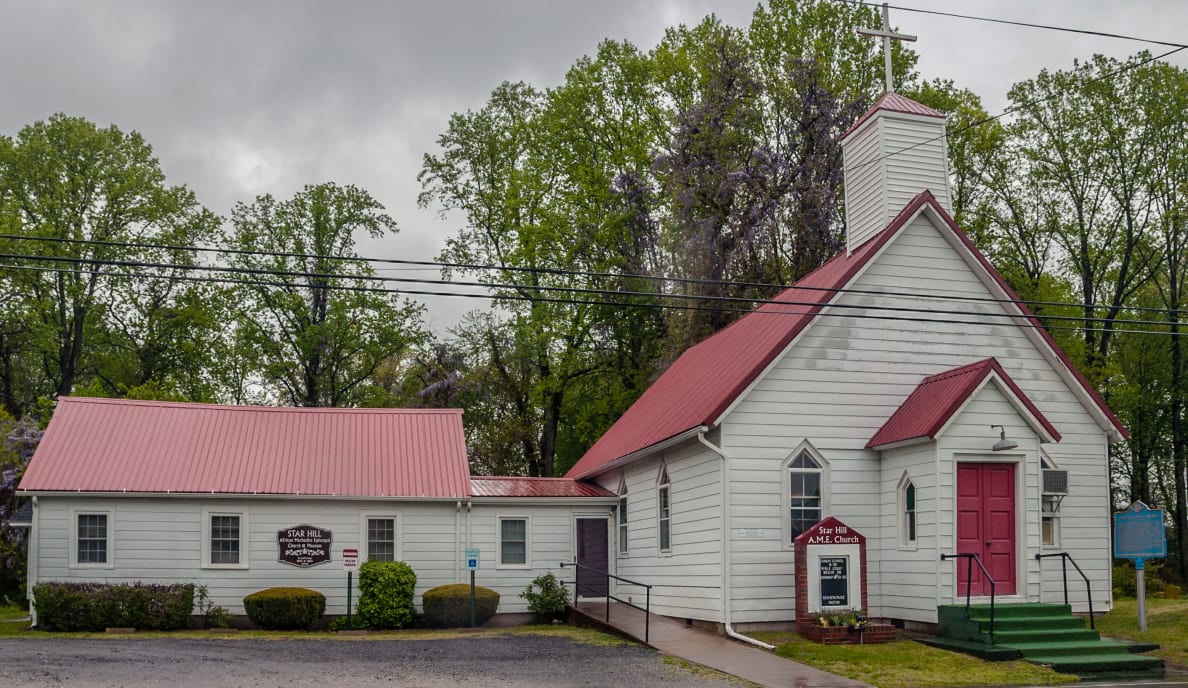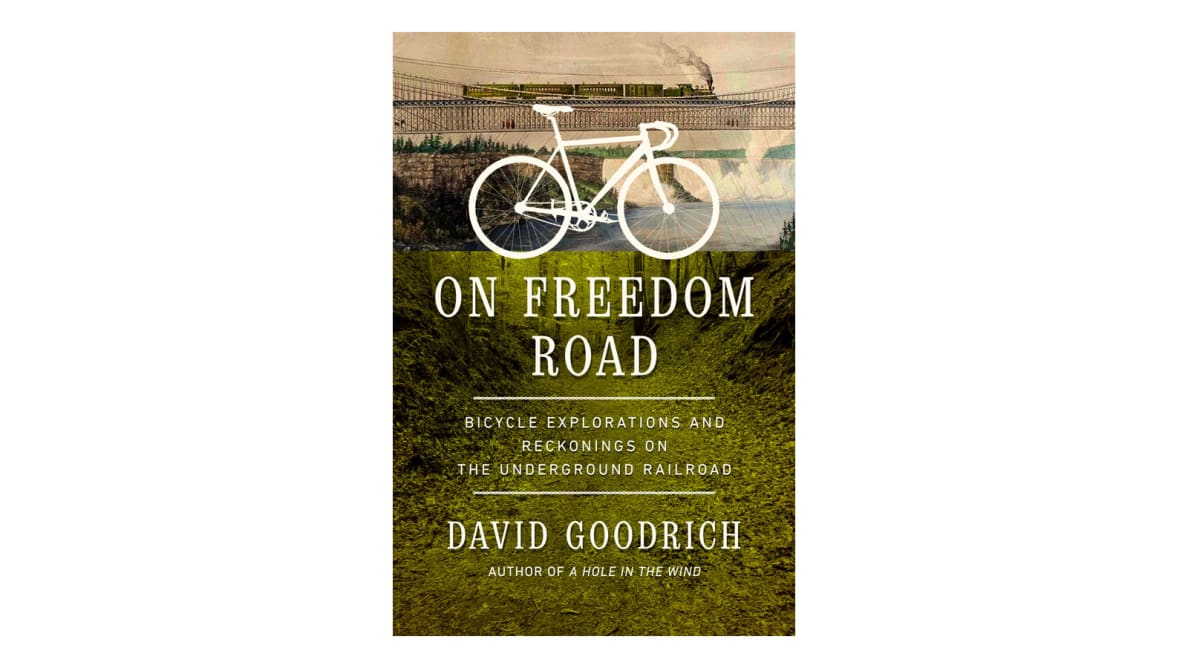I couldn’t get in touch. The recording said, “Have a blessed day,” and I left messages on the voice mail and on the Facebook page with no reply. But we had one more shot. It happened that we three cyclists would be riding through on a Sunday morning. Maybe we would just stop in for services. We had to try. After all, this was the Star of the East.
The Star Hill African Methodist Episcopal (AME) Church in Dover, Delaware has a long history with the Underground Railroad. There aren’t many hills in Delaware. Star Hill was built on a little rise by a local Black congregation in 1842 so that freedom seekers might be able to see it. The local historian speculated that the congregation originally called it Star of the East because freedom seekers would actually be coming east from Maryland. As we would discover on our bicycle journey to Canada, the AME churches were central stops on the road to freedom. This one still stands. We wanted to see it, at least from the outside.
The early morning sun was firing up for a hot one. We had a sixty-mile day laid out, starting north on the Eastern Shore through Greensboro, Maryland, then to Sandtown, Dover, and Wilmington, Delaware. In interviews long after her Underground Railroad days, Harriet Tubman told historian Wilbur Siebert that this was her preferred route. As we rolled north into the heat, we made a first stop before crossing into Delaware.
Almost immediately after turning off the main road north of Denton, we began to regret it. The road turned to loose dirt and gravel. On the downhill stretch, I began to fishtail, almost going down several times. Up ahead, Lynn was having a hard time finding a line through the soft sand. Then the grade gradually settled out into a deep cool forest. Dismounting from the bikes, we wandered into a quiet little wonderland by the river. The stream gently coursed over a small dam, and we dangled our feet in the water.
The spot is known as Red Bridges, and it’s the first place where the Choptank River is narrow and shallow enough to wade across. Freedom seekers would cross here, far back in the woods, to a place just a few miles from the state line. More patrols and hunters waited once they crossed into Delaware, but the travelers were almost out of Maryland. There was a feeling of sacredness to this little glen. Sunbeams filtered down through the trees, and there was the sound of moving water. On the opposite bank, a dad was teaching his daughter how to fish. On his phone, Rick found a version of the spiritual “Wade in the Water.” We know that Harriet Tubman used songs as signals when leading groups on the run, and this may have been one of the songs. The lines filtered out through the glen:
Who’s that young girl dressed in red?
Must be the children that Moses led.
Who’s that young girl dressed in white?
Must be the children of the Israelite.
Who’s that yonder dressed in blue?
Must the children that made it through.
God gonna trouble the water…
The cool woods were tempting, but Sunday prayers waited. We rolled back out onto the main road. Lynn pulled us over for a quick selfie at the Delaware sign, the first state line we would cross. Through the hazy soybean fields, the only breeze was the one we generated. Two hours and twenty miles later, covered in sweat, we rode up to a little red-roofed chapel. The sound of clapping hands and a gospel hymn told of the services going on inside. A woman appeared at the door, eyeing us warily. With their history of being targeted and terrorized, I suspect that Black churches have a certain radar for strangers. We explained that we were following Harriet Tubman’s route to Canada and asked if we might sit in. She nodded and motioned with her hand.
We eased into the back pew of the tiny, blue-walled chapel, trying unsuccessfully to be discreet. The parishioners in their Sunday best gave an occasional glance back at the odd group in spandex behind them. A simple wooden cross hung over the altar. The congregation was primarily African American women, the occasional wave of a fan in evidence. During the hymns, the congregation swayed in the heat, hands reaching above white dresses. John Jordan, the minister, delivered a thunderous sermon in the emotional, call-and-response style. His stories of sin and redemption went from Biblical allegories to tales of the everyday. Salvation rolled down like water. In the midst of the sermon, two women in lace church hats and white gloves slipped out of the chapel. A few moments later they reappeared with our own salvation, a glass of ice water for each of us. The minister continued:
Y’all know I always like to stop for coffee in the morning at the Wawa. Now there’s usually a couple of people in line behind me. And sometimes I’ll tell the clerk to ring up all of their orders too. Then I’ll walk out, but I can’t look at their faces. Because it’s not about me, and it’s not about them. It’s to the greater glory of the Lord.

The Star Hill AME Church in Deleware.
C. E. Couchman/Wikimedia Commons
It was Father’s Day. He recognized the fathers and, to numerous amens, “the women who became fathers.” As the service closed, the ushers passed out envelopes wrapped in gold braid with a handwritten “Happy Father’s Day” inscription. Inside was a small brownie and a sheet of prayers. Among them was Matthew 11:28-30: “Come to me, all you who are weary and heavy laden with care. I will give you rest.”
After the service, the parishioners fussed over us. The ladies in the white gloves, Sondra Ross and Hattie Hogan, led us over to the adjacent hall for refreshments.
“You have to meet Lucreatia,” they said. “She’s who you want to talk to.”
Lucreatia Wilson is the local historian and a longtime member of the church. She pointed to where, under the old chapel, “we sheltered the runaways.” Some years back, she sponsored a panel of Tubman’s great-nieces at Star Hill.
“Do you think that Harriet Tubman came through here?” I asked.
“She had to come this way,” Lucreatia said. “These were Quaker farms, not like [nearby] Camden. The Quakers donated the land for the church, and some of them helped the runaways. We know that she stayed with several conductors around here, like William and Nathanial Brinkley and Abraham Gibbs. This was the route around Camden.”
“You seem to know everything about Star Hill.”
“Well, I’ve been involved with the church since 1952. Before then, we lived in San Antonio, in the Jim Crow South. I still remember the white line on the bus that we had to sit behind. Then my father was stationed at Dover Air Force Base, so we moved up here.”
“When I was growing up, we knew a farmer and a minister by the name of Solomon Gibbs. Several times a week he would gather us at the vegetable garden and tell us stories of slavery and the Underground Railroad. I was just a kid, and I didn’t pay him much attention. But God had a plan. It didn’t come until later when I was driving home from taking my daughter to college. The voice came and said, ‘You will teach history. You will tell the story.’”
“So now I do tours around the area of the Underground Railroad sites. And I used to have kids into the church to talk about what the people went through. We’d cut muslin, potato sack material, into squares, then put jerky, raisins, peanuts on it. Then we’d tie the muslin onto a stick and take the kids on a hike down by the stream to give them an idea of what it was like.”
“It must be quite something to live just down the road from this little church,” I said.
“I love this church more than I love my home,” she said.
Excerpted from On Freedom Road: Bicycle Explorations and Reckonings on the Underground Railroad by David Goodrich with permission from Pegasus Books.



